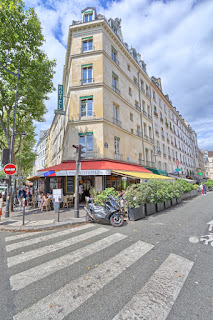Le retour de la Victoire de Samothrace // The Winged Victory of Samothrace
Au coeur d'un bâtiment parisien monumental et dont le rayonnement culturel est international, elle culmine et domine la pierre comme le marbre. En haut d'un escalier blanc et majestueux du Musée du Louvre, se dresse l'impressionnante et fière Victoire de Samothrace. La belle et son socle viennent tout juste de rejoindre leur emplacement après une longue période de rénovation. Elle apparaît ainsi comme à son premier jour, soit vers 190 avant J-C…
Prodigieux travail d'un sculpteur au génie indéniable, la Victoire de Samothrace prend sa source dans le sanctuaire des Dieux situé sur une île de la mer Egée. Constituée de plusieurs blocs de marbre, on ne sait hélas quelle victoire elle célèbre exactement. Cependant, elle représente la déesse Niké, traditionnellement située à l'avant des navires. Les ailes déployées, la jambe relevée, la sculpture semble s'être posée délicatement sur un bateau représenté par le socle. Un équilibre parfait est organisé par l'artiste puisque le poids de la statue permet à l'avant de la base de remonter, lui donnant ainsi la forme d'un navire.
Découverts en 1863 sur l'île du même nom, les différents blocs furent définitivement assemblés vingt ans plus tard. Bien qu'une main fut également découverte, nous ignorons toujours la posture originelle de la sculpture. Avait-elle un bras tendu vers le ciel et un autre le long du corps, tenant dans la main disparue un trophée de guerre? Beaucoup de secrets autour de la merveilleuse Victoire de Samothrace, beaucoup de mystère mais aussi beaucoup d'imaginaire autour de la belle. Et lorsqu'en approchant du bas de l'escalier on découvre peu à peu la divinité dans son ensemble, tel un navire voguant sur les mers du Louvre, on remercie l'histoire, le talent, le travail et le Musée pour cette formidable émotion que l'on ressent…
Victoire de Samothrace
Musée du Louvre
*****
In the heart of a monumental Parisian building and whose cultural influence is international, it culminates and dominates the stone and marble. On top of a big white staircase of the Louvre Museum, stands the impressive and proud Winged Victory of Samothrace. This beauty and her base just join came back after a long renovation period. It appears as if it was its first day, about 190 before Christ …
Prodigious work of a genius sculptor, the Winged Victory of Samothrace was taking place in the sanctuary of the gods located on an island in the Aegean Sea. Made of several blocks of marble, we do not unfortunately know what victory she celebrated. However, it represents the goddess Nike, traditionally at the front of the ships. With outstretched wings, and a raised leg, the sculpture appears to be delicately placed on a ship, represented by the base. A perfect balance was achieved by the artist since the weight of the statue allows the front of the base up, giving it the shape of a ship.
Discovered in 1863 on the island of Samothrace, the different blocks were finally assembled twenty years later. Although a hand was also discovered, we do not know the original posture of the sculpture. Did she had a tense arm skyward and another along the body, holding in his hand a trophy of war? Many secrets about the wonderful Winged Victory of Samothrace, a lot of mystery also but a lot of imagination around it. And when approaching the bottom of the stairs, we discover, little by little, the Victory as a whole, like a sail on the seas of the Louvre, we thank History, talent, work and the Museum for that great emotion we feel …
The Winged Victory of Samothrace
Louvre Museum





